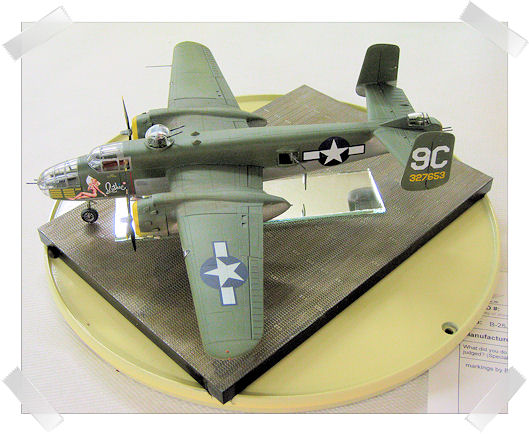|

Ruthie; Hasegawa B-25J Mitchell in 1/72nd
scale
by Ed Potkai
Freshman English 101
required that I read a then-recent novel by Joseph
Heller. Bitterly funny, Catch 22 turned out to be the
greatest novel Iíve ever read. Heller based the work on
some of his experiences as a navigator on the island of
Corsica during 1944. For a long time Iíd wanted to pay
tribute to Heller and his great characters. When
Bombshell Decals released its 1/72 Corsica B-25 sheet, I
could finally do it.
Heller served with the 340th Bomb Group, 488th Bomb
Squadron. Bombshellís sheet covered only the 488th
sister units, the 486th and the 489th. I chose to do
Ruthie, arguably the finest nude painted in WWII. The
big ď9Ē on Ruthieís tail identifies her as belonging to
the 489th.
In March of 1944, most of the 340th B-25Cís and Dís were
destroyed by an eruption of Mt Vesuvius. The unit was
moved to Corsica and the aircraft were replaced with new
B-25Jís in natural metal. After a raid on their base by
German bombers, the group scrambled to camouflage the
topsides of their airplanes. The aircraft were painted
in the field with scavenged paint, thought to be British
or Italian dark green.
In building this model, I wanted to develop skills in
highlighting and shading, especially in the interior of
the aircraft. To that end, I sprayed the interior with
burnt umber as a primer. Then interior green was applied
sparingly to portray the actual color. OD was applied to
the bomb bay as shown in a reference. Washes and,
finally, lightened shades highlighted the stringers and
other details. Moving to assembly, as I began to glue
parts, I found them often breaking off, taking the paint
with them. A little research revealed the problem. That
primer coat of burnt umber was an acrylic paint that I
had mislabeled as enamel.
I was not happy to see that the nose gear strut (as well
as the tail guns) needed to be attached before the
fuselage halves were united. It is a thin part and I was
certain that I would snap it off before the model was
completed. Fearing that the repair would be forever
fragile, I decided to forego adding weight to the front
of the aircraft. Amazingly, I never did break the strut
and balanced the model by attaching it to a PSP
(perforated steel plate) base by Eduard.
The most challenging part of the Hasegawa kit is the
nose, especially the bombardierís station. The model
offered only bare sidewalls so I added a few black boxes
that were depicted in a reference. I hacked away the
boxed base of the bombardierís seat to make it look more
like a folding chair than a place where he could keep
his toys. The kit is molded to mount four forward guns
while it appears the 340th only retained one. Test
fitting the main windscreen revealed it to be slightly
wider than the fuselage so I used a thin shim to broaden
the opening. The bulkheads did not fit well and needed
to be fine tuned before everything fit correctly.
I had past success in using Floquil Platinum Mist to
depict weathered metal. But apparently I did not thin
the paint enough to match my air pressure and I wasnít
especially pleased with the result. A mist of Testors
silver helped improve the look but next time Iíll use
Alclad II. The top was Testors British Dark Green with
oversprays of tan to vary the coloration.
The Bombshell Decals (get it? theyíre nudes on bombers)
were superb and snuggled down beautifully when assisted
by Mr Mark Softer and Mr Mark Setter. I did not apply
the stencils surmising that they were probably
sacrificed during the in-field paint-over.
As I added parts to the model, I became more and more
afraid to touch it. With wings and tails and gear and
guns pointing out in every direction, I was sure that
disaster lurked. But somehow it became time to hang the
props. With a salute to Orr, Nately, McWatt and, most of
all, Yossarian, Ruthie was finished.
|